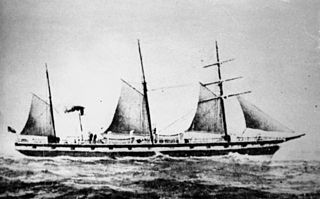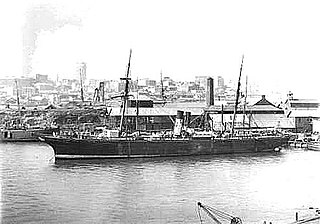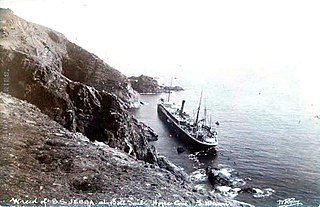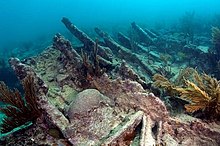
Biscayne National Park is an American national park located south of Miami, Florida in Miami-Dade County. The park preserves Biscayne Bay and its offshore barrier reefs. Ninety-five percent of the park is water, and the shore of the bay is the location of an extensive mangrove forest. The park covers 172,971 acres and includes Elliott Key, the park's largest island and northernmost of the true Florida Keys, formed from fossilized coral reef. The islands farther north in the park are transitional islands of coral and sand. The offshore portion of the park includes the northernmost region of the Florida Reef, one of the largest coral reefs in the world.

SS Yongala was a passenger steamship that was built in England in 1903 for the Adelaide Steamship Company. She sank in a cyclone off the coast of Queensland in 1911, with the loss of all 122 passengers and crew aboard.

Jun'yō Maru (順陽丸) was a cargo steamship that was built in Scotland in 1913, served a succession of British owners until 1927, and was then in Japanese ownership until a Royal Navy submarine sank her in 1944.

SS Newfoundland was a wooden-hulled brigantine and steamship that was built in 1872 and wrecked in 1916. She was a cargo ship, and for part of her career she was a sealing ship. In 1916 she was renamed Samuel Blandford.

Loch Ard was an iron-hulled clipper ship that was built in Scotland in 1873 and wrecked on the Shipwreck Coast of Victoria, Australia in 1878.

Hereward, was British clipper ship that was built in Scotland in 1877. She had an iron hull, three masts and full rig.

Fowey Rocks Light is located seven miles southeast of Cape Florida on Key Biscayne. The lighthouse was completed in 1878, replacing the Cape Florida Light. It was automated on May 7, 1975, and as of 2021 is still in operation. The structure is cast iron, with a screw-pile foundation, a platform and a skeletal tower. The light is 110 feet above the water. The tower framework is painted brown, while the dwelling and enclosed circular stair to the lantern is painted white. The original lens was a first-order drum Fresnel lens which stood about 12 feet (4 m) high and weighed about a ton (tonne). The light has a nominal range of 15 miles in the white sectors, and 10 miles in the red sectors.
SS Castilian was a British cargo steamship and is now a dangerous wreck in the Irish Sea off the coast of North Wales. She was built in 1919 to a standard First World War design. In 1943 while carrying munitions she struck rocks off The Skerries, Isle of Anglesey and sank.
HMS Fowey was a fifth rate warship of the Royal Navy, launched on 14 August 1744 in Hull, England. She spent only four years in commission before she struck a reef and sank in what is known today as Legare Anchorage in Biscayne National Park, off the coast of Florida. She was armed with six, nine, and eighteen pounder guns and crewed with over 200 men.

SS Gothenburg was an iron-hulled sail- and steamship that was built in England in 1854 and sailed between England and Sweden until 1862. She then moved to Australia, where she operated across the Tasman Sea to and from New Zealand until 1873, when she was rebuilt. After her rebuild, she operated in the Australian coastal trade.

Loch Vennachar was an iron-hulled, three-masted clipper ship that was built in Scotland in 1875 and lost with all hands off the coast of South Australia in 1905. She spent her entire career with the Glasgow Shipping Company, trading between Britain and Australia. The company was familiarly called the "Loch Line", as all of its ships were named after Scottish lochs. The ship was named after Loch Venachar, in what was then Perthshire.
SS Norwich City was a British cargo steamship. She was built in 1911 as Normanby, and renamed Norwich City in 1919. She was wrecked in the Pacific Ocean in 1929. For many years her wreck was a sea mark on the atoll of Nikumaroro. The wreck is now largely broken up.

HMS Primrose was a Royal Navy Cruizer-class brig-sloop built by Thomas Nickells, at Fowey and launched in 1807.

City of Adelaide was an iron-hulled ship that was launched in Scotland in 1863, spent a long career in Australian passenger and cargo service, and sank off the coast of Queensland in 1916. She served with several Australian shipowners, including the Australasian Steam Navigation Company, Australasian United Steam Navigation Company and Howard Smith Company.

SS Jebba was a steamship that was built in Middlesbrough in 1896 and wrecked on the south coast of Devon in 1907. She was launched as Albertville for the Compagnie Belge-Maritime du Congo (CBMC), and was renamed Jebba when Elder, Dempster & Co acquired her in 1898. She was the first of four CBMC ships to be called Albertville, and the first of two Elder, Dempster ships to be called Jebba.
The following index is provided as an overview of and topical guide to Wikipedia's articles on recreational dive sites. The level of coverage may vary:

Recreational dive sites are specific places that recreational scuba divers go to enjoy the underwater environment or for training purposes. They include technical diving sites beyond the range generally accepted for recreational diving. In this context all diving done for recreational purposes is included. Professional diving tends to be done where the job is, and with the exception of diver training and leading groups of recreational divers, does not generally occur at specific sites chosen for their easy access, pleasant conditions or interesting features.

Katori Maru was a steam ocean liner of the Empire of Japan. She was built in Nagasaki in 1912–13. In the Second World War the Imperial Japanese Navy requisitioned her as a troop ship. In 1941 a Royal Netherlands Navy submarine sank her off the coast of Sarawak.
Loch Sunart was an iron-hulled sailing ship that was built in Scotland in 1878 for Loch Line's service between Great Britain and Australia. The ship was named after Loch Sunart in Lochaber.















